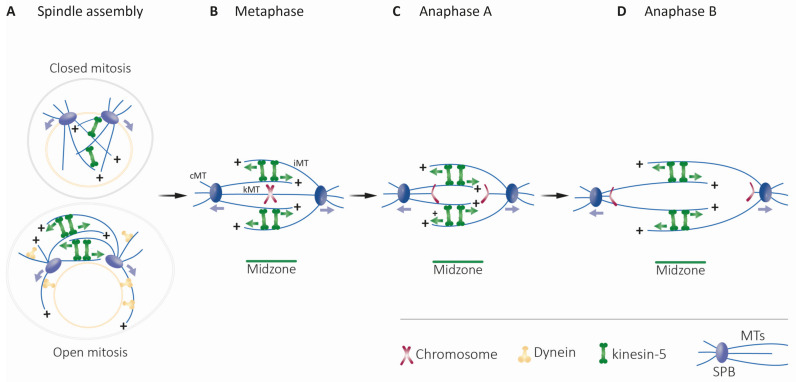Figure 1.
Major roles of kinesin-5 motors in mitotic spindle dynamics (adapted from [10]). (A) Separation of spindle poles during spindle assembly in closed (top) and open (bottom) mitosis [11]. Kinesin-5 motors mediate spindle pole-separation by crosslinking and sliding apart anti-parallel spindle MTs. Dynein, the minus-end-directed motor (yellow shape) contributes to spindle assembly in open mitosis [12,13]. Green and purple arrows indicate the direction of movement of the kinesin-5 motors and the spindle poles, respectively. (B) Metaphase: chromosome congression takes place at the middle of the bipolar spindle. Different types of MTs are indicated: kinetochore MTs (kMTs), astral or cytoplasmic MTs (cMTs) and interpolar MTs (iMTs). At metaphase, the chromosomes contain pairs of sister chromatids that are attached via their kinetochores to kMTs. Kinesin-5 motors stabilize the spindle by crosslinking anti-parallel iMTs of the mid-zone (indicated at the bottom). In metazoans, kinesin-5 motors maintain spindle bipolarity and drive poleward flux [14,15,16]. (C) Anaphase A. The onset of anaphase A. When cohesion between sister chromatids is lost, the sister chromatids are separated and migrate to the opposite spindle poles. In parallel, poleward flux-based depolymerization of kMTs takes place. (D) During anaphase B spindle elongation, the two spindle poles are further separated by an elongating spindle. Such elongation is mediated by cortical forces generated, for example, by dynein motors attached to the cortex which translocate along cMTs. Additional force is provided by kinesin-5-motors by sliding apart anti-parallel iMTs at the spindle mid-zone.

